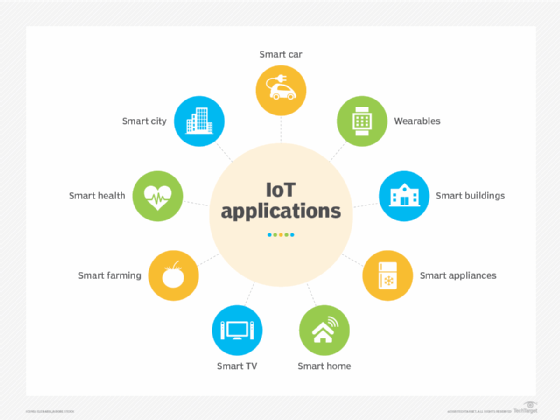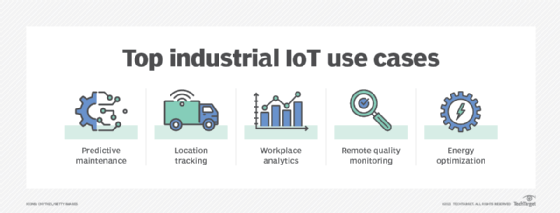
Getty Images/iStockphoto
IoT drives sustainable development and the bottom line
Emerging technologies, including virtual reality, AI and IoT, are critical for organizations to ensure that they remain profitable and sustainable in the long run.
IoT drives sustainable innovation and profitability, whether organizations use the technology to minimize food waste, conserve water or increase energy efficiency.
In recent years, agencies and governmental bodies have increasingly recognized that businesses must play a pivotal role in achieving environmental, social and governance (ESG) goals that benefit all stakeholders. ESG criteria hold organizations to a set of standards that investors can use to assess risk exposure. Organizations across industries can adopt IoT to monitor and lessen the risks their products and processes create.
Explore five ways organizations can use IoT to achieve sustainability and stay competitive.
1. Minimizing food waste through precision farming and smart agriculture
Although population growth has minimized or even reversed in many developed nations, the global population is still expected to increase to 10 billion within this century, according to the United Nations. Food is the most basic necessity for human life. With rising emphasis on environmental sustainability, organizations must adapt new technologies to meet the demand for food in a sustainable manner. Smart agriculture, including precision farming, is one solution. IoT-based smart farming includes both inexpensive sensor-based systems that monitor light, temperature and soil moisture, as well as smart 'actuators' that are able to take real-time action depending on the field conditions, such as automatic water and fertilizer delivery.
With smart agriculture, farmers can already grow higher quality crops and produce more. Smart agriculture leads to more stable food prices in some of the poorest regions, and makes farming more predictable and sustainable. Many organizations already actively incorporate diverse technologies into their business models. The smart farming market size is expected to top 25 billion by the close of this decade, according to Emergen Research.
2. Intelligent infrastructure in smart offices
A smart office uses IoT devices to become an "intelligent ecosystem" that relies on connectivity to control, monitor, manage and optimize the workplace. Advantages of a smart office include improved productivity and workplace safety, more efficient business operations, more comfortable working environments, and, most important to climate change, energy savings. For example, lighting control through localized motion detection, at scale, can lead to significantly less light usage and energy efficiency.
Security presents another aspect of office infrastructure where IoT devices continue to play a critical role, and more organizations invest and innovate. Through sensors, security cameras, smart locks and AI, organizations can enhance their office security. However, connected security devices may lead to privacy concerns. Smart communication and collaboration tools can also make the workplace more productive, such as smart scheduling systems for conference rooms.

3. Increasing energy efficiency across industrial sectors
Organizations in any industry can use IoT to reduce their carbon emissions and increase energy efficiency without loss of productive capacity. Some companies in the energy industry have developed IoT-enabled tools and devices specifically to improve energy efficiency. Other industry verticals, such as manufacturing, can harness similar technologies.
Energy efficiency technologies offer a dual purpose within the business model. Energy conservation makes the company more sustainable, drives the bottom line when it comes to ESG oversight and makes the company more profitable in the long run.
4. Smart filtration and water conservation
Water is a critical ingredient for human life, but more than 3 billion people in the world lack access or find freshwater scarce around the world, especially in some of the poorest regions, according to World Wildlife Fund. IoT can be a major driver of better water usage, especially in filtration and conservation efforts. IoT sensors can provide data in near real time for city water managers to measure, analyze and optimize water use at scale. In the future, smart pricing systems will also reduce unnecessary water usage.
IoT devices can be installed in pumps, distribution networks and storage cisterns for tasks such as predictive maintenance. Even minor percentages of improvement in water conservation, implemented at city or county-level scales, can preserve water, which has increasingly become a precious resource for a growing population.

5. Smart energy production and consumption
According to Smart Energy USA, smart energy is the "process of using devices for energy-efficiency ... [and] focuses on powerful, sustainable renewable energy sources that promote greater eco-friendliness while driving down costs." The predominant form of smart energy discussed today in public discourse is renewable smart energy.
IoT plays an important role in smart renewable energy production because the vagaries of the weather -- which are only expected to get worse in the short term and exhibit more variance -- require real-time optimization and fine-tuning. IoT sensors, actuators and battery storage technology must work in tandem with a modernized energy grid to maximize smart energy production. Equally important is smart energy consumption, which often arises in discussions of the smart home. Devices should be evaluated for their efficiency and ease of use, but equally important is their role in promoting more efficient energy consumption.








